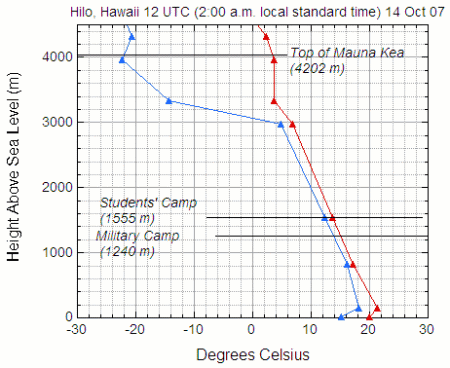What an exciting adventure for both groups! To see what kind of weather they were encountering, I obtained a radiosonde sounding at nearby Hilo, which is located on the east side of the island of Hawaii and east of Mauna Kea. Winds in the sounding were out of the east at 6-12 knots (3-6 meters per second, slightly higher than 6-12 miles per hour,), so the sounding was roughly upwind of the mountain. The students who rode to the top of Mauna Kea wrote that the temperature was at most 3.9 degrees Celsius; slightly warmer than the 2.6 degrees reported during the previous night, but not much.

The time of the sounding was 2:00 a.m. local standard time (3 a.m. local daylight time), so the temperatures the students on the ground would have been somewhat warmer due to daytime heating. If the air upstream of Mauna Kea were cooler than on the mountain at the same height, what effect would strong winds have on the daytime warming of the mountain? How about if the winds were calm?
Astronomers like to observe from Mauna Kea because of the clear, dry air as well as distance from light pollution. (For more about light pollution, see GLOBE at Night). Clouds of course block their view of the sky. But even humid air affects their ability to observe (astronomers look at the sky not only using visible light but also longer wavelengths, where water vapor interferes). Also, the air is very stable, which reduces turbulence overhead, so that astronomers can observe in more detail. (Have you ever seen how images in the distance “shimmer” when you look at them across a hot parking lot on a summer day? The turbulent eddies bend the light going through them slightly, creating the shimmering effect. It’s fun to watch but not very good if you want a sharp image of a building on the other side of the parking lot.)
In addition to having to work to go uphill, the students were probably having some trouble hiking because of the altitude. Taking the sounding, I calculated the air density. By the time they reached the cabin, the air density, and hence the amount of oxygen available, was 85 per cent of the sea level value.

What’s up super article very great info, I can tell that you really have a mastery of this topic. I just added this site to my favorites and will definately swing by again. Is it okay if I follow you on your social media sites? Please make sure to post links to them all if it’s not too much trouble. Thank yo and carry on the amazing work.
Thanks for sharing such a pleasant thought, article is pleasant,
thats why i have read it entirely